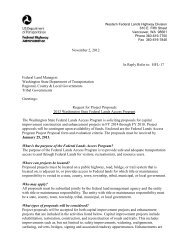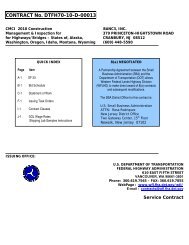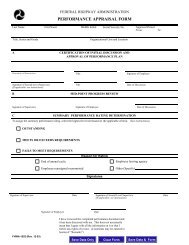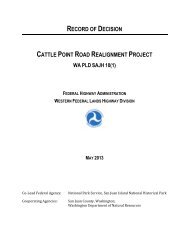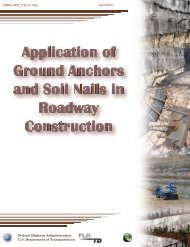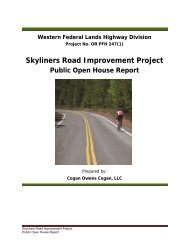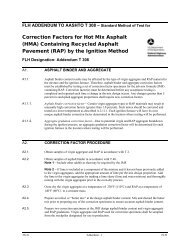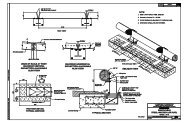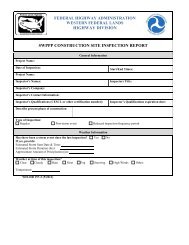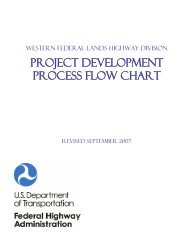FLHP Overview - Western Federal Lands Highway Division - U.S. ...
FLHP Overview - Western Federal Lands Highway Division - U.S. ...
FLHP Overview - Western Federal Lands Highway Division - U.S. ...
Create successful ePaper yourself
Turn your PDF publications into a flip-book with our unique Google optimized e-Paper software.
<strong>Federal</strong> <strong>Lands</strong> <strong>Highway</strong> Program (<strong>FLHP</strong>)<br />
Improving transportation to and within federal and tribal lands<br />
Office of <strong>Federal</strong><br />
<strong>Lands</strong> <strong>Highway</strong><br />
Benefits of the <strong>Federal</strong> <strong>Lands</strong> <strong>Highway</strong> Program<br />
U.S. Department<br />
of Transportation<br />
<strong>Federal</strong> <strong>Highway</strong><br />
Administration<br />
Associate Administrator<br />
John Baxter<br />
202-366-9494<br />
john.baxter@dot.gov<br />
www.fhwa.dot.gov/flh/<br />
<strong>Federal</strong> <strong>Lands</strong> <strong>Highway</strong><br />
provides planning,<br />
design, and engineering<br />
services to support the<br />
highways and bridges<br />
that provide access to<br />
and within federally<br />
owned lands.<br />
What are the benefits of the <strong>Federal</strong><br />
<strong>Lands</strong> <strong>Highway</strong>s Program (<strong>FLHP</strong>)?<br />
• The U.S. Department ofTransportation<br />
Office of <strong>Federal</strong> <strong>Lands</strong> <strong>Highway</strong> (FLH)<br />
and its partner agencies provide and<br />
help to maintain the road networks in<br />
and around federal lands that welcome<br />
more than 550 million Americans<br />
visitors annually.<br />
• Visitors to federal lands spent $39<br />
billion in 2006, accounting for almost<br />
7% of all tourism spending in the<br />
United States.<br />
Indian Reservation Roads (IRR) Program<br />
94,400 miles of roads<br />
Park Roads and Parkways (PRP) Program<br />
9,550 miles of roads<br />
1,414 bridges<br />
63 tunnels<br />
Public <strong>Lands</strong> <strong>Highway</strong> (PLH) Program<br />
29,200 miles of roads (Forest <strong>Highway</strong>s)<br />
Refuge Roads (RR) Program<br />
4,900 miles<br />
265 bridges<br />
5,153 parking lots<br />
• Recreation activities at the local level<br />
support 373,000 jobs in the retail,<br />
dining, and hospitality sectors.<br />
• Each year, approximately 790 miles<br />
of the nearly 300,000-mile federal<br />
public road system is improved. Road<br />
rehabilitation and maintenance<br />
impacts create new income and<br />
spending for local communities<br />
surrounding federal lands.<br />
• From 2004-2009, it is estimated<br />
that funding for federal lands through<br />
the SAFETEA-LU transportation<br />
authorization will create over 20,000<br />
jobs annually.<br />
April 2008<br />
See http://www.fhwa.dot.gov/flh/<br />
for sources<br />
<strong>Lands</strong> and facilities are also administered by other<br />
<strong>Federal</strong> <strong>Lands</strong> <strong>Highway</strong> Program partner agencies,<br />
including the U.S. Army Corps of Engineers, the Bureau of<br />
Land Management, the Bureau of Reclamation, and the<br />
Department of Defense.<br />
Bureau of Indian Affairs/Tribal Governments<br />
Fish and Wildlife Service<br />
National Park Service<br />
U.S. Forest Service
Benefits of the <strong>Federal</strong> <strong>Lands</strong> <strong>Highway</strong> Program<br />
Banking on Nature, a recent study by the US Fish and Wildlife Service, 35 million<br />
people visited national wildlife refuges in 2006, supporting almost 27,000 private sector<br />
jobs and producing about $543 million in employment income. In addition, recreational<br />
spending on refuges generated nearly $185.3 million in tax revenue at the local, county,<br />
state and federal level.The economic benefit is almost four times the amount appropriated<br />
to the Refuge System in FiscalYear 2006. About 87 percent of refuge visitors travel<br />
from outside the local area and the local benefits of visitation are dependent on a<br />
robust and well-maintained transportation network.<br />
Moab, Utah, is an area that is very distinctive physically—its unique rock formations<br />
and amazing landscape make it an extraordinary location.The National Park Service<br />
and the Bureau of Land Management share responsibility of managing the popular site<br />
that received 781,672 visitors in 2005. Due to its growth, preliminary analyses are<br />
underway to evaluate alternative transportation options at Moab’s Arches National<br />
Park to reduce park congestion.These alternative transportation plans will encourage<br />
recreational bicycle use and other forms of transit that will not affect park views.<br />
Visitors to the Moab area spend $85 million annually.This level of spending maintains<br />
over 1,500 direct service, recreation, retail, and recreation jobs within the local community,<br />
not including federal employees. Local income and supplier growth create another<br />
300 jobs indirectly. In terms of aggregate sales, the Moab region captures $88 million in<br />
annual direct and indirect sales and over $28 million in personal income.<br />
<strong>Federal</strong> Land Management Agencies (FLMAs)<br />
receive aid from almost 250,000 volunteers,<br />
providing an estimated economic benefit of<br />
more than $90 million per year.<br />
The <strong>Federal</strong> <strong>Lands</strong> <strong>Highway</strong> Program lends<br />
critical support to allow for access at places such<br />
as Arches National Park.Visitors come to take in<br />
breathtaking natural scenery, and their stays<br />
result in significant economic benefits to local<br />
gateway communities.



